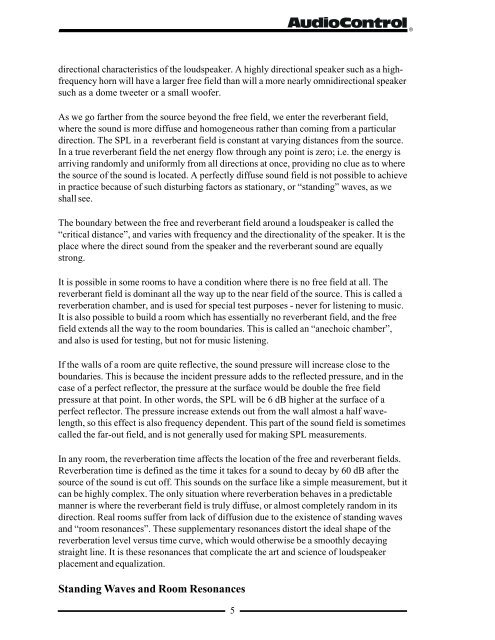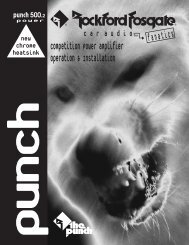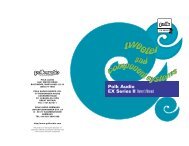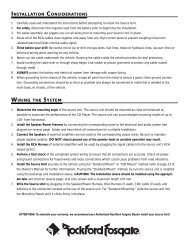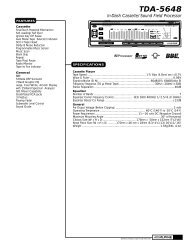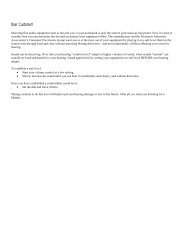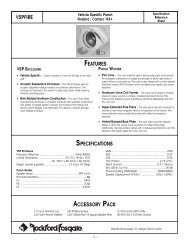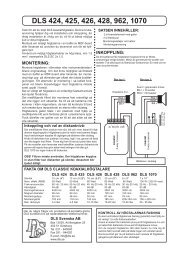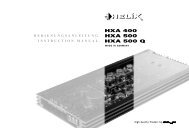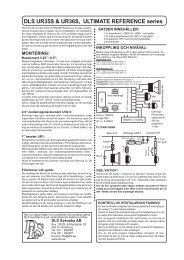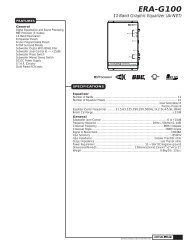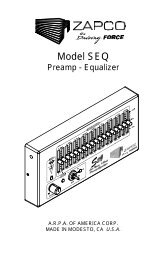Small Room Acoustics De-Mythologized - Eporia
Small Room Acoustics De-Mythologized - Eporia
Small Room Acoustics De-Mythologized - Eporia
You also want an ePaper? Increase the reach of your titles
YUMPU automatically turns print PDFs into web optimized ePapers that Google loves.
®directional characteristics of the loudspeaker. A highly directional speaker such as a highfrequencyhorn will have a larger free field than will a more nearly omnidirectional speakersuch as a dome tweeter or a small woofer.As we go farther from the source beyond the free field, we enter the reverberant field,where the sound is more diffuse and homogeneous rather than coming from a particulardirection. The SPL in a reverberant field is constant at varying distances from the source.In a true reverberant field the net energy flow through any point is zero; i.e. the energy isarriving randomly and uniformly from all directions at once, providing no clue as to wherethe source of the sound is located. A perfectly diffuse sound field is not possible to achievein practice because of such disturbing factors as stationary, or “standing” waves, as weshall see.The boundary between the free and reverberant field around a loudspeaker is called the“critical distance”, and varies with frequency and the directionality of the speaker. It is theplace where the direct sound from the speaker and the reverberant sound are equallystrong.It is possible in some rooms to have a condition where there is no free field at all. Thereverberant field is dominant all the way up to the near field of the source. This is called areverberation chamber, and is used for special test purposes - never for listening to music.It is also possible to build a room which has essentially no reverberant field, and the freefield extends all the way to the room boundaries. This is called an “anechoic chamber”,and also is used for testing, but not for music listening.If the walls of a room are quite reflective, the sound pressure will increase close to theboundaries. This is because the incident pressure adds to the reflected pressure, and in thecase of a perfect reflector, the pressure at the surface would be double the free fieldpressure at that point. In other words, the SPL will be 6 dB higher at the surface of aperfect reflector. The pressure increase extends out from the wall almost a half wavelength,so this effect is also frequency dependent. This part of the sound field is sometimescalled the far-out field, and is not generally used for making SPL measurements.In any room, the reverberation time affects the location of the free and reverberant fields.Reverberation time is defined as the time it takes for a sound to decay by 60 dB after thesource of the sound is cut off. This sounds on the surface like a simple measurement, but itcan be highly complex. The only situation where reverberation behaves in a predictablemanner is where the reverberant field is truly diffuse, or almost completely random in itsdirection. Real rooms suffer from lack of diffusion due to the existence of standing wavesand “room resonances”. These supplementary resonances distort the ideal shape of thereverberation level versus time curve, which would otherwise be a smoothly decayingstraight line. It is these resonances that complicate the art and science of loudspeakerplacement and equalization.Standing Waves and <strong>Room</strong> Resonances5


